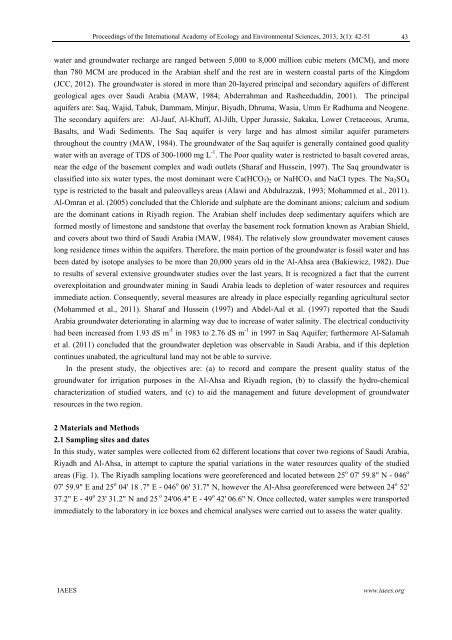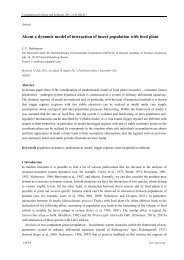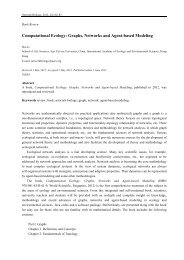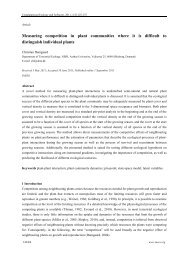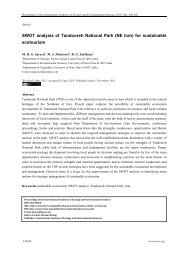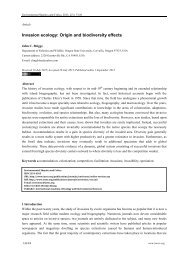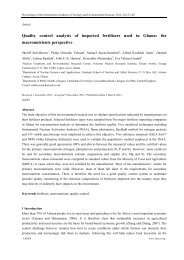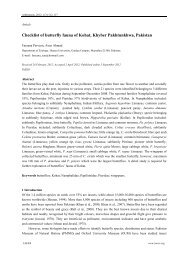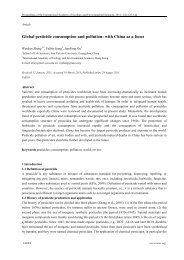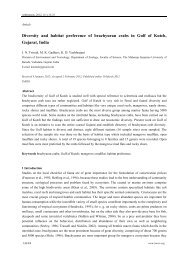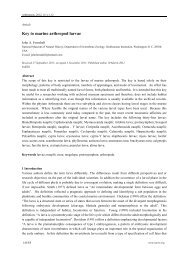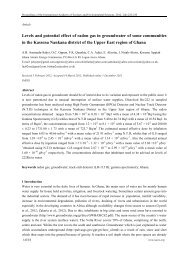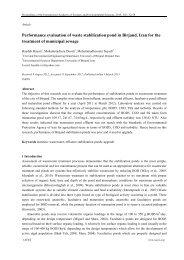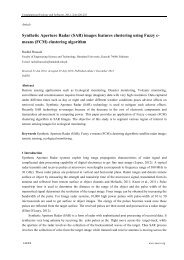Hydrochemical and quality of water resources in Saudi Arabia ...
Hydrochemical and quality of water resources in Saudi Arabia ...
Hydrochemical and quality of water resources in Saudi Arabia ...
You also want an ePaper? Increase the reach of your titles
YUMPU automatically turns print PDFs into web optimized ePapers that Google loves.
Proceed<strong>in</strong>gs <strong>of</strong> the International Academy <strong>of</strong> Ecology <strong>and</strong> Environmental Sciences, 2013, 3(1): 42-51<br />
43<br />
<strong>water</strong> <strong>and</strong> ground<strong>water</strong> recharge are ranged between 5,000 to 8,000 million cubic meters (MCM), <strong>and</strong> more<br />
than 780 MCM are produced <strong>in</strong> the <strong>Arabia</strong>n shelf <strong>and</strong> the rest are <strong>in</strong> western coastal parts <strong>of</strong> the K<strong>in</strong>gdom<br />
(JCC, 2012). The ground<strong>water</strong> is stored <strong>in</strong> more than 20-layered pr<strong>in</strong>cipal <strong>and</strong> secondary aquifers <strong>of</strong> different<br />
geological ages over <strong>Saudi</strong> <strong>Arabia</strong> (MAW, 1984; Abderrahman <strong>and</strong> Rasheedudd<strong>in</strong>, 2001). The pr<strong>in</strong>cipal<br />
aquifers are: Saq, Wajid, Tabuk, Dammam, M<strong>in</strong>jur, Biyadh, Dhruma, Wasia, Umm Er Radhuma <strong>and</strong> Neogene.<br />
The secondary aquifers are: Al-Jauf, Al-Khuff, Al-Jilh, Upper Jurassic, Sakaka, Lower Cretaceous, Aruma,<br />
Basalts, <strong>and</strong> Wadi Sediments. The Saq aquifer is very large <strong>and</strong> has almost similar aquifer parameters<br />
throughout the country (MAW, 1984). The ground<strong>water</strong> <strong>of</strong> the Saq aquifer is generally conta<strong>in</strong>ed good <strong>quality</strong><br />
<strong>water</strong> with an average <strong>of</strong> TDS <strong>of</strong> 300-1000 mg L -1 . The Poor <strong>quality</strong> <strong>water</strong> is restricted to basalt covered areas,<br />
near the edge <strong>of</strong> the basement complex <strong>and</strong> wadi outlets (Sharaf <strong>and</strong> Husse<strong>in</strong>, 1997). The Saq ground<strong>water</strong> is<br />
classified <strong>in</strong>to six <strong>water</strong> types, the most dom<strong>in</strong>ant were Ca(HCO 3 ) 2 or NaHCO 3 <strong>and</strong> NaCI types. The Na 2 SO 4<br />
type is restricted to the basalt <strong>and</strong> paleovalleys areas (Alawi <strong>and</strong> Abdulrazzak, 1993; Mohammed et al., 2011).<br />
Al-Omran et al. (2005) concluded that the Chloride <strong>and</strong> sulphate are the dom<strong>in</strong>ant anions; calcium <strong>and</strong> sodium<br />
are the dom<strong>in</strong>ant cations <strong>in</strong> Riyadh region. The <strong>Arabia</strong>n shelf <strong>in</strong>cludes deep sedimentary aquifers which are<br />
formed mostly <strong>of</strong> limestone <strong>and</strong> s<strong>and</strong>stone that overlay the basement rock formation known as <strong>Arabia</strong>n Shield,<br />
<strong>and</strong> covers about two third <strong>of</strong> <strong>Saudi</strong> <strong>Arabia</strong> (MAW, 1984). The relatively slow ground<strong>water</strong> movement causes<br />
long residence times with<strong>in</strong> the aquifers. Therefore, the ma<strong>in</strong> portion <strong>of</strong> the ground<strong>water</strong> is fossil <strong>water</strong> <strong>and</strong> has<br />
been dated by isotope analyses to be more than 20,000 years old <strong>in</strong> the Al-Ahsa area (Bakiewicz, 1982). Due<br />
to results <strong>of</strong> several extensive ground<strong>water</strong> studies over the last years, It is recognized a fact that the current<br />
overexploitation <strong>and</strong> ground<strong>water</strong> m<strong>in</strong><strong>in</strong>g <strong>in</strong> <strong>Saudi</strong> <strong>Arabia</strong> leads to depletion <strong>of</strong> <strong>water</strong> <strong>resources</strong> <strong>and</strong> requires<br />
immediate action. Consequently, several measures are already <strong>in</strong> place especially regard<strong>in</strong>g agricultural sector<br />
(Mohammed et al., 2011). Sharaf <strong>and</strong> Husse<strong>in</strong> (1997) <strong>and</strong> Abdel-Aal et al. (1997) reported that the <strong>Saudi</strong><br />
<strong>Arabia</strong> ground<strong>water</strong> deteriorat<strong>in</strong>g <strong>in</strong> alarm<strong>in</strong>g way due to <strong>in</strong>crease <strong>of</strong> <strong>water</strong> sal<strong>in</strong>ity. The electrical conductivity<br />
had been <strong>in</strong>creased from 1.93 dS m -1 <strong>in</strong> 1983 to 2.76 dS m -1 <strong>in</strong> 1997 <strong>in</strong> Saq Aquifer; furthermore Al-Salamah<br />
et al. (2011) concluded that the ground<strong>water</strong> depletion was observable <strong>in</strong> <strong>Saudi</strong> <strong>Arabia</strong>, <strong>and</strong> if this depletion<br />
cont<strong>in</strong>ues unabated, the agricultural l<strong>and</strong> may not be able to survive.<br />
In the present study, the objectives are: (a) to record <strong>and</strong> compare the present <strong>quality</strong> status <strong>of</strong> the<br />
ground<strong>water</strong> for irrigation purposes <strong>in</strong> the Al-Ahsa <strong>and</strong> Riyadh region, (b) to classify the hydro-chemical<br />
characterization <strong>of</strong> studied <strong>water</strong>s, <strong>and</strong> (c) to aid the management <strong>and</strong> future development <strong>of</strong> ground<strong>water</strong><br />
<strong>resources</strong> <strong>in</strong> the two region.<br />
2 Materials <strong>and</strong> Methods<br />
2.1 Sampl<strong>in</strong>g sites <strong>and</strong> dates<br />
In this study, <strong>water</strong> samples were collected from 62 different locations that cover two regions <strong>of</strong> <strong>Saudi</strong> <strong>Arabia</strong>,<br />
Riyadh <strong>and</strong> Al-Ahsa, <strong>in</strong> attempt to capture the spatial variations <strong>in</strong> the <strong>water</strong> <strong>resources</strong> <strong>quality</strong> <strong>of</strong> the studied<br />
areas (Fig. 1). The Riyadh sampl<strong>in</strong>g locations were georeferenced <strong>and</strong> located between 25 o 07' 59.8" N - 046 o<br />
07' 59.9" E <strong>and</strong> 25 o 04' 18 .7" E - 046 o 06' 31.7" N, however the Al-Ahsa georeferenced were between 24 o 52'<br />
37.2" E - 49 o 23' 31.2" N <strong>and</strong> 25 o 24'06.4" E - 49 o 42' 06.6" N. Once collected, <strong>water</strong> samples were transported<br />
immediately to the laboratory <strong>in</strong> ice boxes <strong>and</strong> chemical analyses were carried out to assess the <strong>water</strong> <strong>quality</strong>.<br />
IAEES<br />
www.iaees.org


